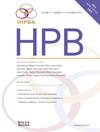在俄罗斯入侵乌克兰后的战争中对胰腺损伤患者的治疗。
IF 2.4
3区 医学
Q2 GASTROENTEROLOGY & HEPATOLOGY
引用次数: 0
摘要
背景:胰腺创伤的处理是复杂的,并没有得到很好的理解。与军事创伤相关的胰腺损伤具有较高的发病率和死亡率。本研究旨在分析乌克兰冲突期间一家大型HPB中心胰腺损伤患者的手术治疗结果。方法:将2022年2月24日至2023年12月31日期间在沙利莫夫国家外科和移植科学中心胰腺和胆管外科住院的患者的前瞻性数据收集到数据库中。胰腺损伤患者仔细检查治疗模式确定。结果:48例胰腺外伤患者住院治疗。39例发生急性创伤后胰腺炎,其中9例出现胰瘘。在胰腺损伤患者中,进行了以下手术:EUS胰液收集引流(PFC) 2/48, US引导下经皮引流11/48,剖腹手术和坏死切除术7/48,EUS引导下胰切除术合并膀胱胃造口或膀胱十二指肠造口4/48。15例患者行膀胱空肠吻合术、膀胱胃吻合术或膀胱十二指肠吻合术,9例行瘘胰空肠吻合术。2例(4.2%)患者死亡。结论:在重症胰腺损伤的治疗中,个性化的手术治疗策略,更倾向于使用微创技术,可以实现康复。本文章由计算机程序翻译,如有差异,请以英文原文为准。
Treatment of patients with pancreatic injuries during the war after Russian invasion of Ukraine
Background
Management of pancreas trauma is complex and not well understood. Pancreas injury associated with military trauma is associated with high morbidity and mortality. This study aims to analyze the results of surgical treatment of patients in a major HPB center with pancreatic injuries during the Ukraine conflict.
Methods
Between 24 February 2022 to 31 December 2023, prospectively collected data on patients admitted to Department of Pancreatic and Bile Ducts Surgery in the Shalimov National Scientific Center of Surgery and Transplantology was collected into a database. Patients with pancreas trauma were scrutinized treatment patterns identified.
Results
48 patients with pancreatic trauma were admitted. Acute posttraumatic pancreatitis occurred in – 39 patients, 9 patients presented with a pancreatic fistula. Among patients with pancreatic injuries the following procedures were performed: EUS drainage of pancreatic fluid collection (PFC) 2/48, US guided percutaneous drainage 11/48, laparotomy and necrosectomy 7/48, EUS–guided pancreatonecrsecctomy with cystogastrostomy or with cystoduodenostomy 4/48. In 15 patients we performed cystojejunostomy, cystogastrostomy or cystoduodenostomy, in 9 patients - fistulopancreatojejunostomy. Mortality occurred in 2 (4.2 %) patients.
Conclusions
Personalized tactics of surgical treatment, preferring the use of minimally invasive techniques allow to achieve recovery in the treatment of severely wounded with pancreatic injuries.
求助全文
通过发布文献求助,成功后即可免费获取论文全文。
去求助
来源期刊

Hpb
GASTROENTEROLOGY & HEPATOLOGY-SURGERY
CiteScore
5.60
自引率
3.40%
发文量
244
审稿时长
57 days
期刊介绍:
HPB is an international forum for clinical, scientific and educational communication.
Twelve issues a year bring the reader leading articles, expert reviews, original articles, images, editorials, and reader correspondence encompassing all aspects of benign and malignant hepatobiliary disease and its management. HPB features relevant aspects of clinical and translational research and practice.
Specific areas of interest include HPB diseases encountered globally by clinical practitioners in this specialist field of gastrointestinal surgery. The journal addresses the challenges faced in the management of cancer involving the liver, biliary system and pancreas. While surgical oncology represents a large part of HPB practice, submission of manuscripts relating to liver and pancreas transplantation, the treatment of benign conditions such as acute and chronic pancreatitis, and those relating to hepatobiliary infection and inflammation are also welcomed. There will be a focus on developing a multidisciplinary approach to diagnosis and treatment with endoscopic and laparoscopic approaches, radiological interventions and surgical techniques being strongly represented. HPB welcomes submission of manuscripts in all these areas and in scientific focused research that has clear clinical relevance to HPB surgical practice.
HPB aims to help its readers - surgeons, physicians, radiologists and basic scientists - to develop their knowledge and practice. HPB will be of interest to specialists involved in the management of hepatobiliary and pancreatic disease however will also inform those working in related fields.
Abstracted and Indexed in:
MEDLINE®
EMBASE
PubMed
Science Citation Index Expanded
Academic Search (EBSCO)
HPB is owned by the International Hepato-Pancreato-Biliary Association (IHPBA) and is also the official Journal of the American Hepato-Pancreato-Biliary Association (AHPBA), the Asian-Pacific Hepato Pancreatic Biliary Association (A-PHPBA) and the European-African Hepato-Pancreatic Biliary Association (E-AHPBA).
 求助内容:
求助内容: 应助结果提醒方式:
应助结果提醒方式:


